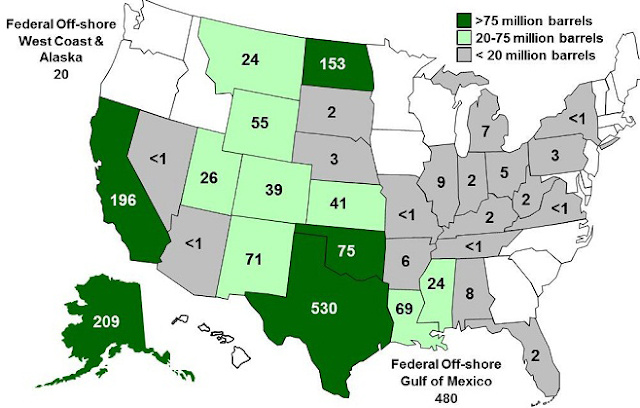United States proven oil reserves declined to a little more than 21 gigabarrels by the end of 2004 according to the Energy Information Administration, a 46% decline from the 39 gigabarrels it had in 1970 when the huge Alaska North Slope ('ANS') reserves were booked. No oil fields of similar size have been found in the US since the ANS discoveries. With over 2.3 million wells having been drilled in the US since 1949,[12] there are very few undrilled areas left where another supergiant oil field could remain undiscovered. As a result, it appears that most US oil reserves have already been discovered. As oil fields get closer to the end of production, estimates of what is left become more accurate. Consequently, US oil reserve numbers are very accurate compared to those of other countries.
United States crude oil production peaked in late 1970 at over 4 gigabarrels per year, but declined to 1.8 gigabarrels per year by early 2006 (only 11 years of future production). In fact, production in the fall of 2005 fell to only 1.5 gigabarrels per year as a result of hurricanes in the Gulf of Mexico — a level not seen since shortly after World War II. At the same time, US consumption of petroleum products increased to over 7.3 gigabarrels per year. The difference ( 5.5 gigabarrels ) was mostly made up by imports, with the largest supplier being Canada, which increased its exports of crude oil and refined products to the US to 0.8 gigabarrels per year at the end of 2005. Imports of oil and products now account for nearly half of the US trade deficit. In early 2007, the Energy Information Agency (EIA) of the U.S. Department of Energy projected that in 2007 oil consumption would rise to 20.9 million barrels per day, while oil production would fall to 5.1 million barrels per day, meaning that oil consumption would be nearly four times as high as oil production.[13]
The United States has the largest known concentration of oil shale in the world, according to the Bureau of Land Management and holds an estimated 800 gigabarrels of recoverable oil, enough to meet U.S. demand for oil at current levels for 110 years. Unfortunately, oil shale is much more difficult and expensive to extract and refine than conventional oil and oil sands. Oil shale must be produced by mining rather than drilling, and the shale contains a waxy oil precursor known as kerogen rather than liquid petroleum. Despite that, oil shale could be developed given high enough oil prices, and the technology for converting oil shale to oil has been known since the Middle Ages, although the scale of the mining and processing operations would be vastly greater than anything done in history.
Oil rigs near Huntington Beach, California, USA
Oil rigs near Huntington Beach, California, USA
The main constraint on oil shale development is probably going to be that Canadian and Venezuelan oil sands are only about half as expensive to produce, and the US has full access to Canadian oil sands production under the North American Free Trade Agreement (NAFTA). In addition, there are environmental concerns about oil shale development. The oil shale areas are semi-arid, in which mine scars last for centuries, and are at the headwaters of several important rivers, notably the Powder River in a region in which water rights are very important. These rivers are the source of irrigation water for vast areas of farmland and are the source of drinking water for many major cities. As a result, the oil shales are probably not going to be developed until global oil shortages become very severe.
In December, 2006, the Bureau of Land Management of the US Department of the Interior issued research, development, and demonstration (RD&D) leases for five oil shale projects in Colorado's Piceance basin.

Comments